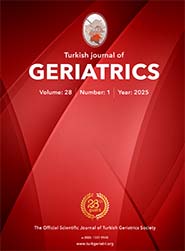2Suleyman Demirel University Faculty of Medicine, Department of Internal Medicine, Division of Hematology, Isparta, Turkey DOI : 10.29400/tjgeri.2025.419 Introduction: We aimed to analyse complete blood count values in patients aged ≥85 and the potential differences in haematological parameters between age groups within this population.
Materials and Method: A retrospective analysis was conducted on 458 patients aged ≥85 who underwent complete blood count testing between 2 February 2005 and 11 October 2023. White blood cell count, neutrophils, lymphocytes, eosinophils, basophils, haemoglobin, platelets, mean corpuscular volume, mean platelet volume, red cell distribution width, mean corpuscular haemoglobin, and mean corpuscular haemoglobin concentration levels were recorded, and their median and mean values were calculated. Patients were stratified into three age groups: 85-89, 90-99, and ≥100 years. The impact of age and sex on complete blood count parameters was assessed. A subgroup analysis was also performed, excluding patients with a history of factors potentially affecting haematological parameters and those with abnormal mean corpuscular volume levels.
Results: Excluding patients with abnormal mean corpuscular volume and a history of factors potentially affecting haematological parameters, we found a notably high prevalence of anaemia (85% in men and 76% in women). No significant differences in haemoglobin values were observed across the age groups. The median platelet, lymphocyte, and white blood cell counts remained within the hospital's normal reference ranges.
Conclusion: The presence of anaemia in older patients aged ?85, based on the current World Health Organization criteria, with no apparent cause after etiologic investigations, may be considered normal in some older individuals.
Keywords : Anaemia; Blood Cell Count; Geriatrics
